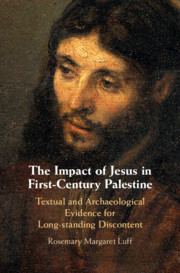 The Impact of Jesus in First-Century Palestine
The Impact of Jesus in First-Century Palestine Book contents
- The Impact of Jesus in First-Century Palestine
- The Impact of Jesus in First-Century Palestine
- Copyright page
- Dedication
- Contents
- Illustrations
- Preface
- Introduction
- Part I Memories of Jesus: The Textual Evidence
- Part II Jesus in Context: The Archaeological Evidence
- 4 Jewish Identities and the Distribution of Ethnic Indicators
- 5 Health Hazards in First-Century Palestine
- 6 Status, Power, and Wealth
- Conclusion
- Bibliography
- Index
5 - Health Hazards in First-Century Palestine
from Part II - Jesus in Context: The Archaeological Evidence
Published online by Cambridge University Press: 26 July 2019
- The Impact of Jesus in First-Century Palestine
- The Impact of Jesus in First-Century Palestine
- Copyright page
- Dedication
- Contents
- Illustrations
- Preface
- Introduction
- Part I Memories of Jesus: The Textual Evidence
- Part II Jesus in Context: The Archaeological Evidence
- 4 Jewish Identities and the Distribution of Ethnic Indicators
- 5 Health Hazards in First-Century Palestine
- 6 Status, Power, and Wealth
- Conclusion
- Bibliography
- Index
Summary
Using archaeological and textual evidence, this chapter discusses the nature and prevalence of infectious disease in early Palestine. An analysis of the human bones from Palestinian tombs, in particular the ones relating to the urban sites of Jerusalem and Jericho, demonstrates a high level of subadult deaths especially of infants. Those socially and economically advantaged were equally at risk with those less well off when faced with an aggressive and persistent pathogen, as evidenced by the Akeldama tombs containing the remains of the wealthy. In one tomb, poor maternal health is suggested by the long-bone measurements of new-born infants, which are well below the norm for the period. And in another tomb (Tomb of the Shroud) both leprosy and tuberculosis were identified in a high-class man, possible a priest. Yet another Akeldama tomb revealed the remains of a man severely infected by the hydated tapeworm Echinococcus granulosus. Malaria is described by Josephus with reference to a Hasmonean king in the first century BCE, but there is no evidence that it was a serious problem in the first century, and certainly there is no evidence for the deadly falciparum form.
- Type
- Chapter
- Information
- The Impact of Jesus in First-Century PalestineTextual and Archaeological Evidence for Long-standing Discontent, pp. 114 - 144Publisher: Cambridge University PressPrint publication year: 2019
